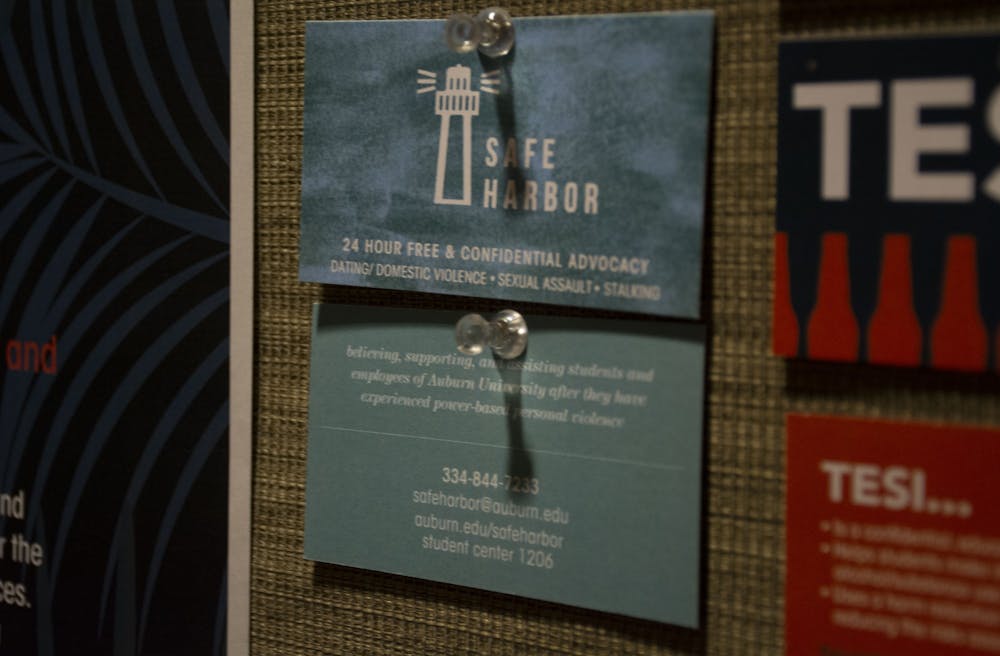Over a decade ago at Auburn University, Safe Harbor was born, an addition to the existing staff of administrative support, directors, and counselors focused on survivor response. What started as a grant-funded project from the U.S. Department of Justice with three volunteers has now grown into a multi-faceted response team for cases of sexual assault and abuse.
Judith White is the new coordinator for violence prevention and survivor advocacy at Safe Harbor. White acknowledged that each case they receive is unique, so Safe Harbor works to tailor a response to their individual needs.
“We kind of let them take the lead and get that autonomy back,” White said.
After calling Safe Harbor, a survivor will be presented with a variety of options they can pursue. The caller can respond with a simple “yes” or “no” to indicate whether they would like to receive that entity’s services or not. People seeking help can contact Safe Harbor 24/7 at (334-844-7233).
Resources that are available to survivors include Student Counseling and Psychological Services, the Auburn University police precinct, short-term and long-term academic aid, Office of Student Conduct and medical care. Within the first 72 hours after assault, the survivor can also receive a forensic exam.
“We have people call us an hour after they were assaulted, we have people who were assaulted three years ago,” said Bridget Nelson, a graduate assistant who has worked with Safe Harbor the past two years. “You can really come to Safe Harbor at any time and our services remain the same.”
Safe Harbor recognizes that not every survivor wishes to report their assault to the police. However, for those who do, the Auburn Police Division has a campus precinct located on West Magnolia Avenue that Safe Harbor works closely with.
Eric Smith, the director for Health Promotion and Wellness Services, said APD and the campus precinct are “the same entity.” Additionally, Smith said the staff at Safe Harbor has the cellphone number of the assistant chief police, who they can text when in need of a detective.
“The police department is great to work with,” Smith said.
Recently, the redesigned Campus Safety building has a room made to create a more comfortable and safe space for survivor interviews to take place. Safe Harbor also has access to this room.
While Safe Harbor focuses on the reactive portion of responding to survivors, five years ago Green Dot was created to be the proactive piece. Green Dot is a bystander training program, which the staff at Auburn hopes to push more in the upcoming fall semester.
Nelson, who currently works with Green Dot, said the program focuses on “educating people on what power-based personal violence is.” This includes sexual assault, stalking, and dating and domestic violence. Green Dot seeks to educate students on the signs of those abused, how to recognize them, and how to react as a bystander.
“It kind of engages the whole community,” Nelson said. “So it's not really putting the responsibility on the person who's being harmful or the person who's being harmed.”
When Green Dot started, the team saw an increase in people who were contacting Safe Harbor, too.
“We fully expected that to happen, just because people are going to be more aware of the issue, more aware of the resources, and things like that," Smith said.
Green Dot is centered around a three-pronged response: direct, delegate, and distract. These concepts and more are presented on the concourse, at partnership events, or by request from those affiliated with the University. Green Dot offers both general overviews of the program, as well as in-depth, hours-long training.
“There are ways we can look out for one another, but [we are] really trying to push the conversation beyond that… To have it not be so much on potential survivors having to prevent something from happening, but to push that no one should have to,” White said.
White said the purpose of Green Dot is to “get people back in the mindset for looking out for one another”. Additionally, Green Dot seeks to change the culture of how the community views assault prevention.
"I think... one thing we’ve done an incredible job of just in the past five [to] six years is putting systems and support around the program itself, so it functions at an incredibly high-level rate now,” Smith said. “Training and the record-keeping have gotten so much better.”
Do you like this story? The Plainsman doesn't accept money from tuition or student fees, and we don't charge a subscription fee. But you can donate to support The Plainsman.





